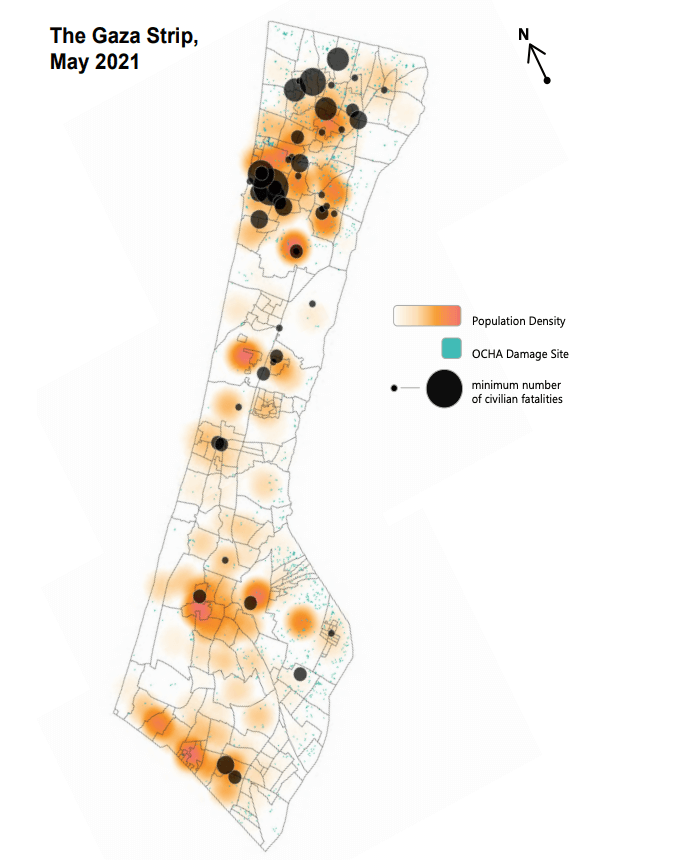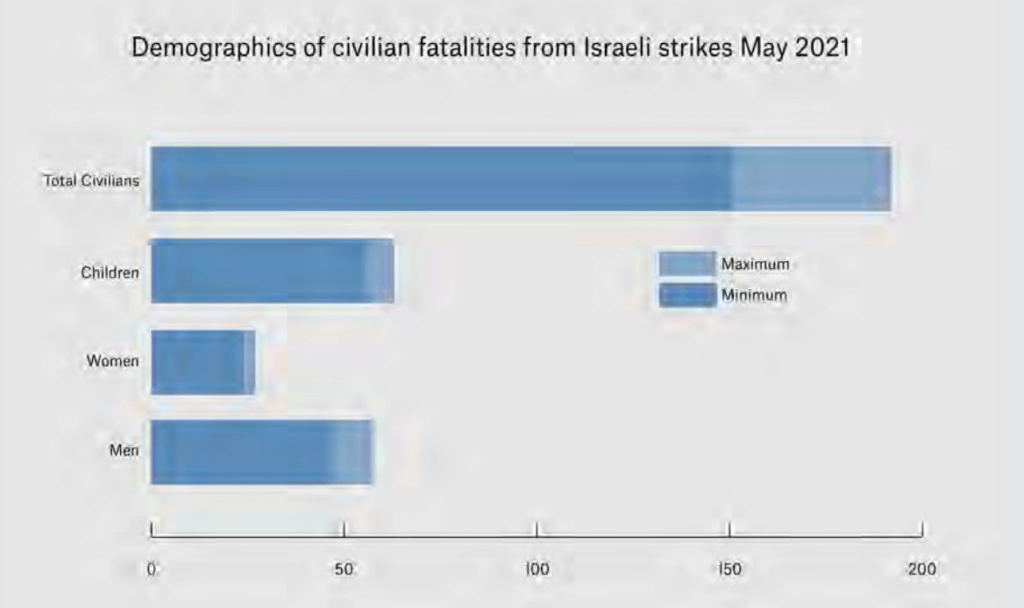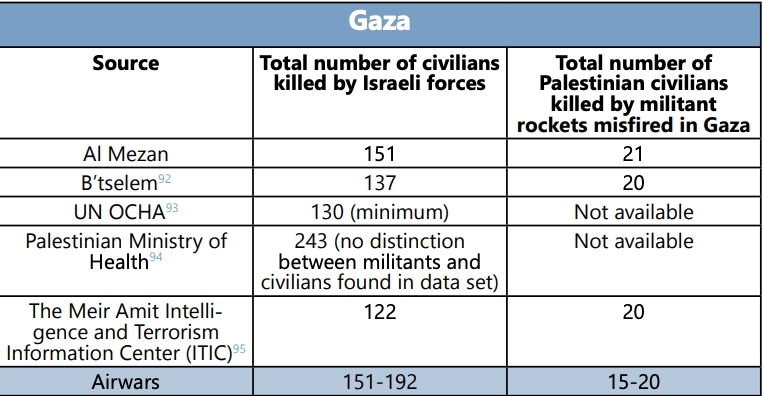A new report has revealed the devastating cost of explosive weapons used on civilian life in the Gaza Strip during Israel’s May offensive on the besieged coastal enclave, which killed an estimated 259 Palestinians.
Airwars, a UK-based nonprofit that tracks and documents civilian harm in conflict zones, released a new report and interactive map documenting the effects that Israel’s offensive had on civilian life in Gaza, one of the most densely populated places on earth.
The 11-day offensive on Gaza claimed 259 Palestinian lives, according to the Gaza Ministry of Health. Of those casualties, Airwars estimated that between 151 and 192 were “non-combatant” civilians.
While the vast majority of civilian casualties came as a result of Israeli airstrikes, Airwars estimated that between 15 and 20 civilian deaths were the result of misfires by Palestinian groups inside the territory. Ten Israeli civilians were also killed as a result of Palestinian rocket fire, the report said.
In its research, Airwars found that over the course of the 11 days, one of the primary “drivers of civilian harm” was the population density of the areas that were bombed, with the most civilian casualties being reported in areas with high population density.

Throughout the course of the 11-day offensive, Israeli military leaders and security officials perpetuated the narrative that the army carried out “targeted attacks” that aimed to minimize civilian harm.
These claims were reiterated in a statement to Airwars; an army spokesperson saying that during the offensive, “the IDF struck military targets belonging to Hamas and other terror organizations in the Gaza Strip. In particular, the IDF struck rocket capabilities, weapons development and production facilities, cyber warfare capabilities and underground infrastructure; all in order to prevent the continuous rocket fire on Israel and to eliminate the threat faced towards Israeli civilians.”
“While terror organizations in the Gaza Strip deliberately embed their military assets in densely populated civilian areas, the IDF takes every feasible measure to minimize harm to civilians and civilian property as much as possible…” the Israeli official said.
According to Airwars’ findings, however, among the estimated 1,500 airstrikes carried out by Israeli forces, which claimed to only target Palestinian militant and military outposts, “militants were regularly targeted in non-military settings,” by Israel, leading to high levels of civilian harm.
In fact, according to the report, in more than 70% of incidents where civilians were reported harmed in Gaza during May 2021, Airwars “found no local or official reports of militants having also been killed or injured in the attacks. That is, civilians were the only known victims.”
“Most civilian fatalities occurred in densely populated areas of Gaza. Of the 1,500 strikes declared on the territory by the IDF in May 2021, eight percent (128 events) had associated civilian harm claims,” the report said.

Airwars went on to say that “these high levels of civilian casualties during May 2021 – at least 151 civilians killed and 555 injured in just eleven days of fighting…could and should have been anticipated by the IDF.”
The group also countered the army’s claims that it routinely warned civilians in Gaza of an impending airstrike in order to “minimize” civilian harm, saying “according to our assessments we found only two out of 116 civilian harm events where local sources said that they had been warned before an attack.”
“The Gaza campaign in particular can be seen as part of a profoundly worrying trend in which States and others conduct intensive military actions in urban areas, often with devastating results,” the report said.
Children among most affected
The report noted that, as is the case with Israel’s previous three offensives on Gaza, Palestinian children paid a particularly high price during the offensive, with children 17 and under making up over a third of all reported civilian deaths.
“Children were killed on almost every day of Israeli strikes on Gaza,” the report said, with one of the deadliest days of the offensive for Palestinian children being May 13th, the Eid al-Fitr holidays, when 10 children were killed.

“On both May 12th and May 13th, when most Palestinians in Gaza were celebrating Eid al-Fitr, the ending of the month of Ramadan, Airwars researchers identified the highest numbers of reported civilian harm events of the conflict – with 17 and 16 individual civilian harm events reported, respectively,” the report said.
Airwars also noted that at least 72% of children were killed either at night or in the evening, when the vast majority of Israeli airstrikes were carried out.
Attacks on ‘military targets’ caused significant civilian harm
In the single deadliest day of the entire offensive, on May 16th, Israeli forces bombed al-Wahda Street in Gaza City, one of the most densely populated residential areas in the city.
The army claimed that the attack was targeting a network of tunnels underneath the street used by Palestinian militant groups. The airstrikes, however, caused several residential buildings to collapse, wiping out entire families.
According to Airwars, as many as 49 civilians from three different families, including up to 18 children, were killed in what many Gazans now know as the “al-Wahda street massacre.”
“Airwars assessments found that between 56 and 68 civilians were killed in four civilian harm events where Israeli forces reported targeting tunnels. Of these, at least 25 fatalities were likely children. Up to 168 civilians were also reported injured in these events,” the report said.
The report went on to say that, “reports from local sources about both the level of destruction, and the nature of those civilian casualties, also shows that in many cases civilians were killed where no militants appeared to be present – and that even where there were reported military targets, such as the reported Hamas network of tunnels, the loss of civilian life was far greater than even the IDF had expected.”
Israeli actions in Syria vs. Gaza
In its report, Airwars compared the level of civilian harm caused by Israeli airstrikes in Gaza, with a years-long campaign of Israeli airstrikes in Syria, targeting what were reported to be Iranian-backed actors in the country.
“Analysis of these two campaigns shows that in comparison to IDF actions in Gaza, Israeli strikes in Syria are far less likely to result in civilian deaths or injuries,” the report said, noting that since 2013, according to the group’s findings, Israel has killed between 14 to 40 civilians.
That is compared to other foreign actors in the region, like the United States and Russia, whose forces have killed thousands of Syrian civilians in airstrikes over the years.
“The ratio of civilian to militant deaths from IDF actions also differs widely between Gaza and Syria,” the report said. In Gaza, more civilians were killed than militants, Airwars said, whereas in Syria, reports indicate that the Israeli army killed over 600 militants and Syrians and Iranian troops since 2013, significantly more than the alleged number of civilians who were killed.
“Urban strikes on Gaza, Syria and Israel can therefore be viewed as part of a troubling contemporary pattern, in which belligerents sometimes aggressively target high population density areas – with devastating consequences for local communities,” the report said.
“This report further demonstrates that military choices of target and locale lead to profoundly different outcomes for civilians – and that the use of wide area effect explosive weapons in populated areas (EWIPA) will result in often catastrophic harm for affected communities.”
BEFORE YOU GO – Stories like the one you just read are the result of years of efforts by campaigners and media like us who support them by getting the word out, slowly but doggedly.
That’s no accident. Our work has helped create breakthroughs in how the general public understands the Palestinian freedom struggle.
Mondoweiss plays a key role in helping to shift the narrative around Palestine. Will you give so we can keep telling the stories in 2022 that will be changing the world in 2023, 2025 and 2030?
 RSS Feed
RSS Feed















 December 17th, 2021
December 17th, 2021  Awake Goy
Awake Goy  Posted in
Posted in  Tags:
Tags: 













